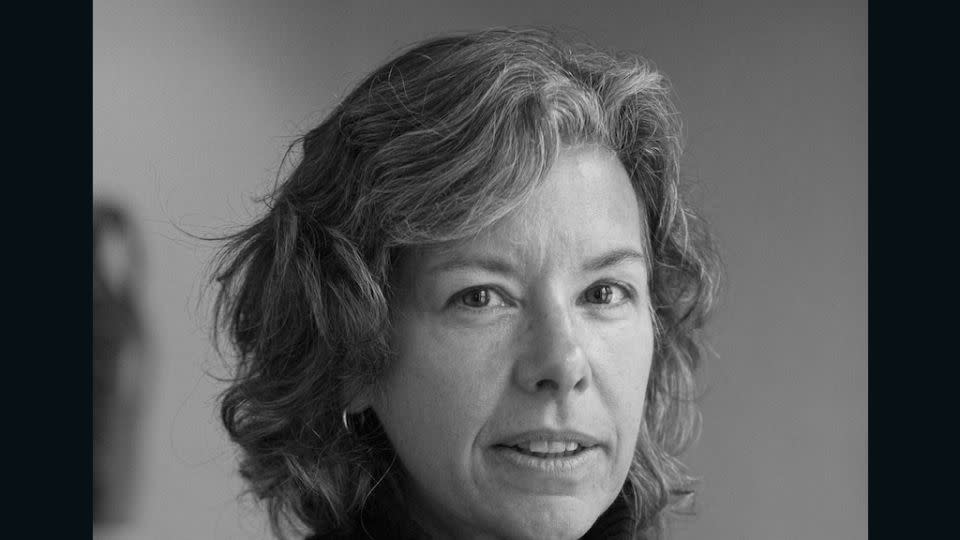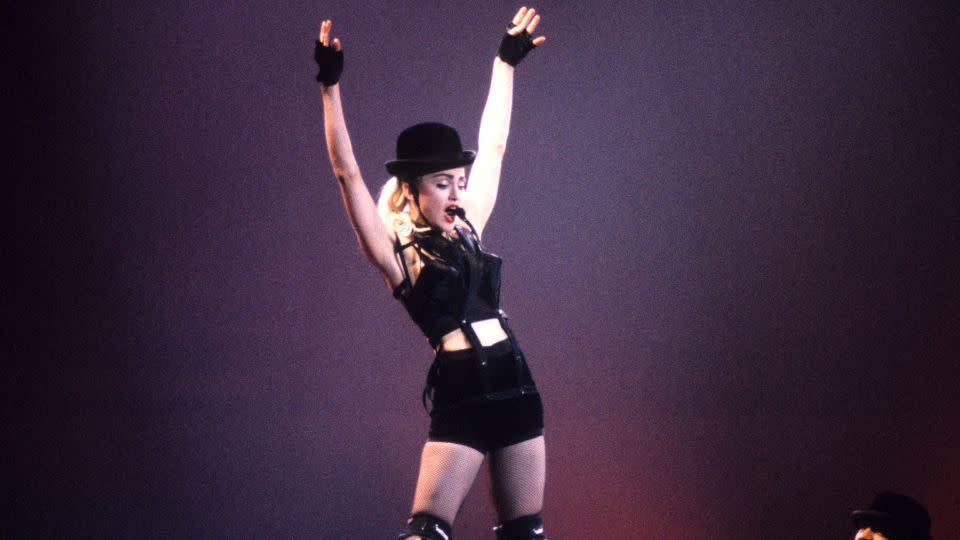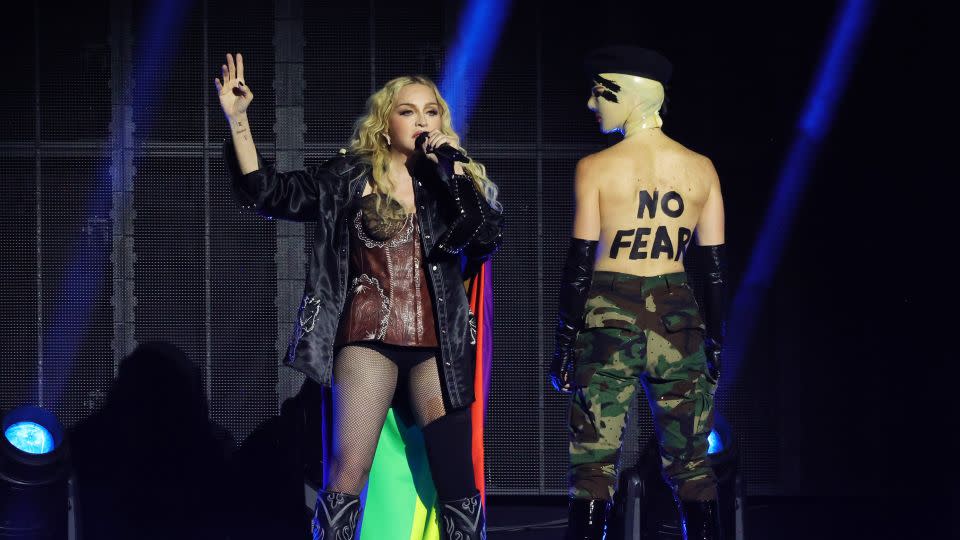Opinion: Madonna’s ‘Celebration Tour’ is her most radical LGBTQ statement in decades
- Oops!Something went wrong.Please try again later.
Editor’s Note: Mary Gabriel is the author of “Madonna: A Rebel Life.” The views expressed in this commentary are her own. Read more opinion on CNN.
As Madonna brings “The Celebration Tour” to New York from Europe for the start of a 52-date North American journey next week, she leaves behind a trail of headlines as long as an asteroid’s tail. There are stories about her remarkable recovery from a life-threatening illness; stories about her fans’ delight that she has finally given them what they have clamored for — a greatest hits tour. And, of course, countless stories dedicated to her wardrobe, her appearance and her personal life.

Largely missing, however, in all that coverage, is a mention of the tour’s political and social significance: “Celebration” is Madonna’s most radical concert statement in support of the LGBTQ community since her paradigm-shifting “Blond Ambition Tour” in 1990, and perhaps her most radical stage performance ever.
At a time when LGBTQ rights are under threat globally, and as US groups supporting those rights issue unprecedented alerts warning of rising assaults, both legislative and physical, Madonna has produced a concert that not only embraces and reassures the gay and trans community, but introduces audiences to the world as she sees it. And it is a remarkable place indeed; a moving, pulsating spectrum of humanity in all its glorious otherness.
Madonna’s show, emceed by Bob the Drag Queen, can only be described as post-gender. The designations “man” and “woman” are irrelevant. The usual markers that indicate male and female are either eliminated or exchanged. Women have shaved heads, men have long hair; women wear trousers, men dresses; both perform topless and yet there is nothing prurient about seeing a woman’s breasts — no more so than a man’s. In the world that Madonna envisions, a person isn’t either/or, they are whatever they want to be. They are themselves; legislators be damned.
“The show is one big statement for freedom and learning to love yourself for who you are and to not give up the fight in being yourself and thus having no fear,” Kimberly van Pinxteren, the webmaster of the fan site MadonnaUnderground, told me. She has seen nine Madonna tours, for a total of 83 shows, and considers “Celebration” to be the artist’s most powerful affirmation of LGBTQ rights in decades.
Every Madonna concert since 1990 has included LGBTQ elements and tributes, some more direct than others. In 2012, for example, during her “MDNA” tour’s stop in St. Petersburg, Russia, she challenged that city’s ban on “gay propaganda,” which she called “a ridiculous atrocity” on her Facebook page, by delivering a defense of gay rights from the stage and distributing rainbow posters emblazoned with the words “No Fear” to concertgoers. (Dozens of concertgoers were arrested and she was sued for more than $10 million by activist groups for “moral damages,” among other perceived transgressions. The lawsuit was dismissed later on.) But only twice in Madonna’s long career has queer and trans culture been the central focus of her show.

The first was in 1990. Madonna’s “Blond Ambition tour” occurred at a time when gay men were dying by the tens of thousands from AIDS. Rather than receive help or comfort, they were largely shunned and shamed. The undercurrent of homophobia that permeated society prior to AIDS began to be expressed openly, and cruelly. When gay men were mentioned in the press, the narrative was about death and the subtext of much of the commentary was that they deserved it. “Blond Ambition” helped change the story.
On stage with Madonna were seven male dancers, only one of whom was heterosexual and three of whom, though she didn’t know it at the time, were HIV positive. The tale she and they told through music and dance was one of life and joy. Her dancers were beautiful, powerful, funny, sexy young men who inspired audiences as much as she did. In fact, they became celebrities as the tour traversed the globe. And when it was over, gay men everywhere could see themselves in those dancers and feel empowered. Many heterosexuals saw gay men differently, too.
Not everyone was convinced. Pope John Paul II called the tour “one of the most satanic shows in the history of humanity.” But the conversation had begun, fear dissipated, closet doors opened. “Madonna 100% helped change the narrative,” Brad Mayer of the Human Rights Campaign (HRC), the largest LGBTQ civil rights group in the United States, told me. “She saw the beauty of people in our community and their contributions. And, so yeah, Blond Ambition was huge.”
Matthew Rettenmund, a writer who has seen every Madonna concert except her first, called the “Blond Ambition” message “very subversive” and a direct response to the times.
Now, decades later, the times called for another such message. In response, Madonna mounted “Celebration,” her second concert with LGBTQ rights at its core.
In its 40 years in operation, the HRC has only issued one emergency declaration and that was this past June. State legislatures at that point had passed a record 76 anti-LGBTQ bills out of the 525 that were introduced in 41 states in the first six months of 2023. From “don’t say gay” laws to book and bathroom bans, those most impacted by the measures, according to HRC, were children. The Williams Institute at the UCLA School of Law found that around one third of high school aged transgender youth live in states that prevent them from playing sports and HRC Foundation data determined that around one third of transgender youth aged 13-17 live in states that ban their much-needed medical care.

GLAAD, the world’s largest LGBTQ media advocacy group, issued a similar series of red alerts this year, most recently last month about violence against the community and its allies. “We’ve seen anti-LGBTQ lies and disinformation spewing from the mouths of politicians, served up to millions on social media, and inciting violence everywhere from elementary schools and libraries, to places of worship, to school board meetings, to places of business,” wrote GLAAD president Sarah Kate Ellis.
Internationally, where over 60 countries have anti-LGBTQ laws on the books, the threat is no less widespread.
“Madonna’s tour is coming at a time of this ongoing state of emergency for LGBTQ+ Americans and it really provides a lot of critical context,” HRC press secretary Cullen N. Peele told me. “This fight is very much far from over. Culture has moved on in so many incredible ways, but there are political forces who cannot tolerate that and they’re pulling up the emergency brake and they are trying so hard to turn back the clock.”
Pop culture can change minds in ways academics, pundits, or politicians can’t by “showing” rather than “telling,” and showing is what Madonna does best.
The dance clubs she emerged from in early 1980s New York were palaces of inclusion and freedom; everyone and everything was allowed. It was a loving environment and a repudiation of an increasingly repressive world outside those walls. That vibe is at the core of Madonna’s “Celebration” show. She hasn’t simply resurrected her life story to showcase her greatest hits, she has resurrected an era so audiences in need of hope can find courage.
The arc of a Madonna concert always travels from darkness to light, and this tour is no exception. Singing “Live To Tell” near the start of the show, Madonna is surrounded by massive photographs of the people she loved and lost to AIDS, followed by increasingly small photos representing some of the hundreds of thousands of people in the US — and tens of millions of people globally — who have died of the disease. The performance is a remembrance, tribute, and acknowledgement that the HIV-AIDS plague continues because, according to US government statistics, people aged 13-34 account for 58% of new AIDS cases in 2021.
Her concert’s storyline proceeds from that dark moment as her 24 dancers try to find a way to continue. Using religious imagery, they hang as martyrs on an altar during “Like A Prayer.” They return as boxers in a ring prepared to fight during “Papa Don’t Preach,” and as a pile of writhing flesh in nude body stockings during “Justify My Love.” In that case, they are people who dare to show their love despite the backlash. After Madonna’s next song, “Vogue” — her iconic early statement on gay and trans culture — she is arrested. Asking, “What did we do? We were just having some fun,” Madonna is roughed up and taken away.
Like Madonna herself, the LGBTQ community she showcases is only strengthened by adversity. The words “No Fear” appear as body paint on a dancer’s naked torso and in video messages on huge screens. Pride flags proliferate. As the show unfolds, the performance becomes bolder, more explicit. Sexual, social, racial and ethnic boundaries don’t just dissolve, they don’t exist. The result is pure carnival, pure fun, mad joy.
By the end, the audience is immersed in Madonna’s world as it once was after “Blond Ambition.” It’s a world where personal freedom is limitless, if it’s allowed to be. And that, according to the Madonna doctrine, is a good thing. Forty years into her career, her advice remains what it has always been: have courage and by all means, express yourself.
For more CNN news and newsletters create an account at CNN.com

